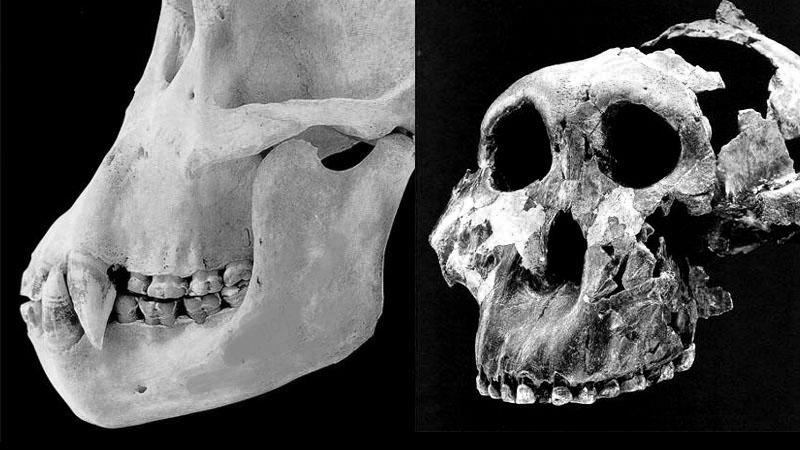The Technology of Spears and Digging Sticks
Episode #2 of the course Technologies that transformed humanity by Richard L. Currier, PhD
More than four million years ago, certain prehistoric apes ancestral to humans began to walk and run on their hind legs. While this revolutionary event required major changes to the skull, spine, pelvis, legs, knees, and feet, scientists have never agreed on the exact reasons why hominids adopted two-legged, or “bipedal,” locomotion.
Why Two-Legged Locomotion Evolved
Scientists disagree about this question. The most common theories for the evolution of bipedal locomotion in humans begin with the fact that when humans began to evolve, the environment of prehistoric Africa was experiencing a drying trend, causing the grasslands to expand and the tropical forests to shrink. These theories argue that walking and running on two legs enabled prehistoric hominids to cover long distances over the open ground, exposed less of the body to the fierce tropical sun, or enabled hominids to see over the tops of tall grasses.
Yet, all the other mammals who adapted to this grasslands environment remained entirely four-legged, including primates such as baboons and other ground-living monkeys.
The “grasslands theory” suffered a major blow in 1995, when the fossil remains of Ardipithecus ramidus, a prehistoric ape 4.4-million years old, were discovered in Ethiopia. Ardipithecus was the first primate to show evidence of bipedal locomotion, yet it lived in the forests and never inhabited the grasslands at all.
However, precisely when our ancestors adopted bipedal locomotion, they permanently lost their weapons-grade canine teeth. This often-ignored fact suggests the likely answer to the riddle of bipedalism.
Prehistoric Hominids Lose Their Biological Weapons
All mammals have horns, antlers, claws, hooves, tusks, or sharp teeth to defend themselves against their natural enemies. All prehistoric and modern apes have long, sharp canines that can fatally wound their enemies in close combat. But all trace of weapons-grade canine teeth had completely disappeared by the time the oldest prehistoric hominids appeared.

The weapons-grade canines of our ape-like ancestors (LEFT: chimpanzee) had completely disappeared by the age of the earliest hominids (RIGHT: Zinjanthropus).
A species’ natural defenses disappear only when they are no longer needed for survival. Hominids can throw stones, but killing a predator requires a stone too heavy to throw with sufficient accuracy. Heavy clubs can crush a predator’s skull, but only in close combat. If you are close enough to hit a leopard over the head with a club, it will already have its fangs at your throat.
So, how did the early hominids defend themselves against deadly predators with only their “bare hands”? No doubt the hands of the early hominids were not bare. They must have been carrying weapons. Since wild chimpanzees sharpen sticks to make spears, the prehistoric hominids doubtless made spears from long wooden sticks—and spears revolutionized both hunting and self-defense.
Why the Long Spear Was a Game-Changer
Although no four-million-year-old spears have ever been found, nothing hominids made of wood has ever survived longer than 350,000 years. Thus, anything of wood four million years old would have long since disappeared. But the sudden disappearance of their weapons-grade canine teeth is clear physical evidence that prehistoric hominids were making and using lethal weapons millions of years ago.
Human hunters can impale both their prey and their natural enemies with long spears and kill them before these animals can get close enough to use their biological weapons. The Maasai warriors of East Africa have been killing lions with long spears for centuries.
Once the long spear had been invented, those hominids who could stand firmly on their hind limbs while jabbing and thrusting with their forelimbs would have had a clear advantage over the hominids who remained on all fours.
Moreover, the long pointed stick would have allowed hominids to dig up roots and tubers growing far beneath the ground, greatly expanding their food supply.
Ultimately, the human body’s unique and much celebrated physical form owes its origin to a group of ancient apes—long since lost in the mists of prehistory—that first mastered the extraordinary offensive, defensive, and food-gathering possibilities of the long, sharp stick.
In tomorrow’s lesson, you will learn how freeing the hands allowed humans to control fire—something no other living thing has ever done. And we will explain how fire enabled our brains to triple in size and make us the smartest animals on Earth.
Recommended reading
Humanity Has New 4.4-Million-Year-Old Baby Mama
Uncovering Ardipithecus Ramidus
Recommended book
Share with friends
